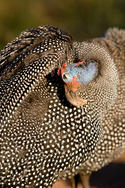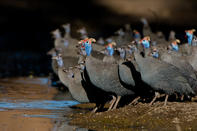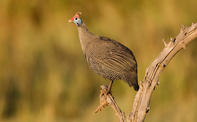An Attentive Suitor

The male guineafowl is an attentive suitor. He defends his chosen mate, brings her grasshoppers to build up her reserves and shows off to her with the typical guineafowl ‘hunch-back’ display.
All this is done at his own expense as he hardly feeds at all during courtship and may drop up to 85% of his body mass.
The female spends all her time prior to laying preening and feeding and fortified with her mate’s nuptial gifts she improves her body mass by 15%.
It is hard to tell guineafowl sexes apart. Males are slightly larger and the only member of the species to engage in the hump-back display.
Thickest Shelled Eggs

Generally producing eggs is an energy-costly exercise to the female bird but particularly so with guineafowl as they produce the thickest shelled eggs of any bird for their size. This is possibly to deter egg-stealing predators.
They also produce large clutches of up to 20 eggs, especially in good rainy seasons. Interestingly a single female may brood up to 50 eggs, the extras having been ‘dumped’ in her nest by other females. The eggs are laid in a rudimentary but well-concealed nest on the ground.
The eggs that guineafowl lay are pyriform in shape, meaning that one end is more pointed. This is a design that allows the egg to roll in a tight circle if it is bumped and prevents eggs from rolling away. The eggs are a creamy colour so to keep them hidden the parent bird conceals them with her body and sits quite still to avoid detection.
During the incubation period, it is the female’s turn to fast as she does all the incubating and does not feed much during this time. By the time the brood hatches, the female needs to replenish her reserves and for the first two weeks of their lives, it is mostly the male bird that cares for the keets (chicks).
The keets depart the nest almost immediately on hatching, as soon as their cryptic downy feathers dry, being well developed (precocial) at hatching. They are unable to regulate their body temperature at this stage and are therefore susceptible to hyperthermia.
Although they can follow the parent birds around, it is still up to the parents to keep them warm by finding them food to metabolize.
The parents are great defenders of their brood and will charge and growl at offending predators valiantly. By the time the chicks can fly, at a mere two weeks old, the individual family units begin to reassemble into larger flocks, which provide greater protection to the individual.
A Creature of Habit

Although guineafowl can fly, they do not do so very often. They will fly a short distance noisily if startled or they will fly up into trees at night to roost out of harm's way. Guineafowl are very much creatures of habit.
They roost at sunset each evening and descend at dawn. The will visit a waterhole in the morning to drink, often parading all in a long line, and here engage in all manner of social and personal hygiene activities, including chasing, between males this maintains a flock hierarchy, dust bathing, and preening. In the afternoons, guineafowl will feed towards water once more for a repeat of the sociality, before roosting for the night.
Guineafowl are opportunistic in their choice of food and their diet includes bulbs, seeds and the stems of plants like Cyperus sedges. They consume large quantities of protein-rich invertebrates during the breeding season.
By Megan Emmett